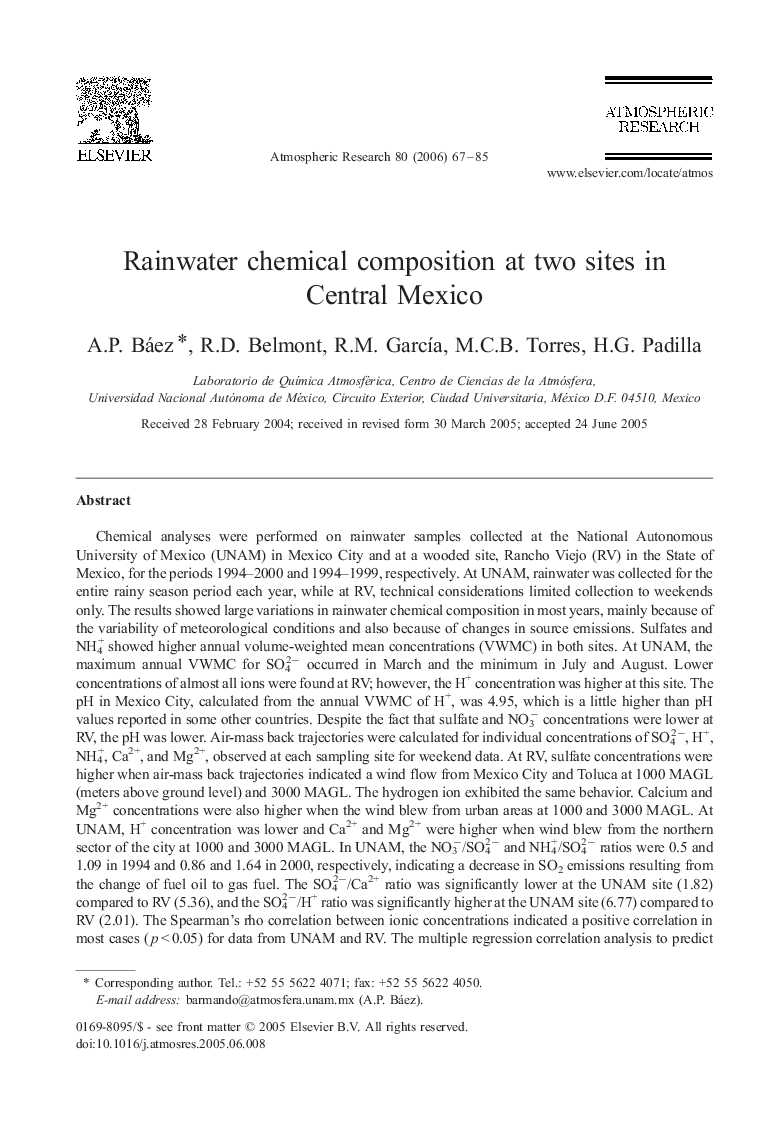| کد مقاله | کد نشریه | سال انتشار | مقاله انگلیسی | نسخه تمام متن |
|---|---|---|---|---|
| 4451575 | 1311765 | 2006 | 19 صفحه PDF | دانلود رایگان |

Chemical analyses were performed on rainwater samples collected at the National Autonomous University of Mexico (UNAM) in Mexico City and at a wooded site, Rancho Viejo (RV) in the State of Mexico, for the periods 1994–2000 and 1994–1999, respectively. At UNAM, rainwater was collected for the entire rainy season period each year, while at RV, technical considerations limited collection to weekends only. The results showed large variations in rainwater chemical composition in most years, mainly because of the variability of meteorological conditions and also because of changes in source emissions. Sulfates and NH4+ showed higher annual volume-weighted mean concentrations (VWMC) in both sites. At UNAM, the maximum annual VWMC for SO42− occurred in March and the minimum in July and August. Lower concentrations of almost all ions were found at RV; however, the H+ concentration was higher at this site. The pH in Mexico City, calculated from the annual VWMC of H+, was 4.95, which is a little higher than pH values reported in some other countries. Despite the fact that sulfate and NO3− concentrations were lower at RV, the pH was lower. Air-mass back trajectories were calculated for individual concentrations of SO42−, H+, NH4+, Ca2+, and Mg2+, observed at each sampling site for weekend data. At RV, sulfate concentrations were higher when air-mass back trajectories indicated a wind flow from Mexico City and Toluca at 1000 MAGL (meters above ground level) and 3000 MAGL. The hydrogen ion exhibited the same behavior. Calcium and Mg2+ concentrations were also higher when the wind blew from urban areas at 1000 and 3000 MAGL. At UNAM, H+ concentration was lower and Ca2+ and Mg2+ were higher when wind blew from the northern sector of the city at 1000 and 3000 MAGL. In UNAM, the NO3−/SO42− and NH4+/SO42− ratios were 0.5 and 1.09 in 1994 and 0.86 and 1.64 in 2000, respectively, indicating a decrease in SO2 emissions resulting from the change of fuel oil to gas fuel. The SO42−/Ca2+ ratio was significantly lower at the UNAM site (1.82) compared to RV (5.36), and the SO42−/H+ ratio was significantly higher at the UNAM site (6.77) compared to RV (2.01). The Spearman's rho correlation between ionic concentrations indicated a positive correlation in most cases (p < 0.05) for data from UNAM and RV. The multiple regression correlation analysis to predict H+ concentration in Mexico City showed that NO3−, NH4+, SO42−, and Ca2+ contributed 23.2%, 20.9%, 8.0%, and 6.1%, respectively, to the H+ prediction, while Cl− plus Na+ plus K+ only contributed 2.2%, and Mg2+ did not contribute. Sea-salt contribution to rainwater chemical composition was negligible with any wind direction at both levels. Excess sulfate (non-sea-salt sulfate) represented 98.7% of the total sulfate in rainwater collected during weekends at RV and 98.6% for weekend and annual rain samples at UNAM.
Journal: Atmospheric Research - Volume 80, Issue 1, April 2006, Pages 67–85